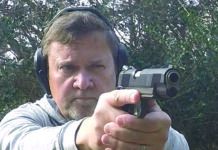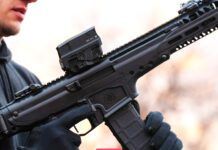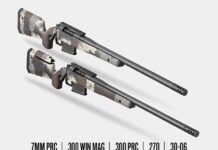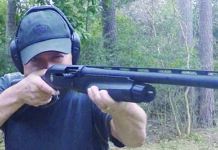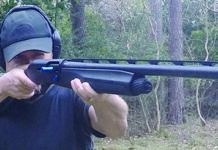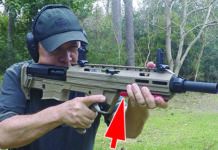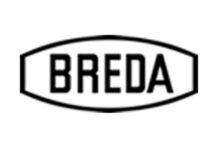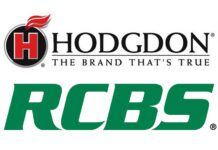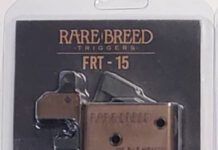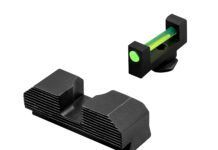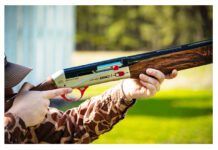When it comes to defending the home, the shotgun is and probably always will be a popular choice. The favorite design for this purpose has long been the pump-action shotgun. Simplicity, low cost, and reliability are their hallmarks. Cycling a pump shotgun relies directly upon the operator, while semiautos load themselves. Perhaps this is why the pump is more widely trusted. In this test we will find out if two semiautomatic shotguns can earn the same high level of confidence as the shuckers have earned. Furthermore, we’ll pit a base-model autoloader against a fully dressed tactical model to see just what upgrades help or hinder. Our test shotguns were the $458 CZ-USA No. 06029 712 Utility 12 gauge and the $700 Mossberg Special Purpose 930 Tactical No. 85360. Both shotguns were constructed with black synthetic stocks and black aluminum receivers. The CZ shotgun was a basic model, as its name would imply. The Mossberg was outfitted with several upgrades from the tactical aftermarket.
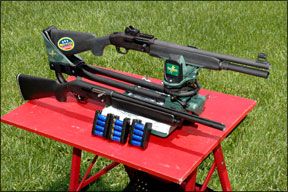
To test our shotguns we did not take them to the skeet range. Nor did we take them hunting. Here is what we were looking for: First, we wanted to find out the size and the density of pattern we could deliver shooting nine-pellet 23⁄4-inch 00 buckshot. Our buckshot test patterns were produced from a maximum distance of 25 yards. We also fired for pattern from 30 feet, a typical distance between a bedroom door and the main entrance of a home. For this test we fired the Winchester Super X XB1200 load, the Federal Low Recoil H132 00-buck shotshells, and Rio Royal Low Recoil shotshells, No. RBLR 129. At first we chamber-loaded one at a time. Then we loaded the magazines to check for cycling. What we found was that our entire supply of Rio slugs and buckshot would be useless in this test. Neither shotgun would cycle the Rio ammunition. In fact, the Mossberg would not even allow it to enter the magazine. Both shotguns were built to chamber 3-inch rounds, so the added length of the Rio (about 0.12 inches) was not the problem. After failing to pass through a MEC shell-check gauge ($12, from recobstargetshop.com), we think it was the high-wall brass that was responsible. However, these rounds cycled easily in the two pump shotguns we tried, a Remington 870 Express Magnum and a Mossberg 590A1.
We also tried firing slug ammunition from a benchrest at a distance of 50 yards. Our choice of slugs was the Federal Vital-Shok TruBall Low Recoil Rifled Slug HP No. PB127 LRS. To help us steady the shotguns and also soak up recoil, we mounted the shotguns in a Caldwell Lead Sled. Test rounds were chronographed to measure velocity and compute muzzle energy.
Semiautomatic firearms require energy supplied by the ammunition to cycle. So we fired less powerful ammunition as well. For this segment of our test, we fired Super Sport Competition Target loads from Estate Cartridge, Inc., and another inexpensive round, Rio’s Trap 32 target load. Both rounds were rated at about 1150 fps and were 23⁄4-inch 23⁄4-dram shells with 11⁄8 ounces of No. 8s. Each of these rounds featured low-brass hulls. Our function-fire test included a timed rapidfire exercise aimed at a steel target placed 12 yards downrange. To ensure safety we chose an Evil Roy Practice Target from actiontarget.com. The Evil Roy was safe to use because it directed the ricochet downward almost directly in front of its collapsible stand. We used a shot-activated timer to record five five-shot strings of fire beginning with an audible start signal. Our intent was to drive the guns as fast as possible to see if we could make them stumble. By racing against the clock we were adding artificial stress. In this way we hoped to learn more about the basic operation of each gun. That is, knocking off the safety, achieving a mount, finding the target and keeping our hits on steel. Start position was port arms with the butt of the gun lowered to about the belt line with the front sight, or bead, held high enough so that it was at the periphery of our sight picture between our eye and the target. Would the performance and reliability of either shotgun be enough to win over a pump-gun devotee? Let’s find out.
Mossberg Special Purpose 930 Tactical No. 85360 3-Inch 12 Gauge, $700
Mossberg lists no less than 23 different Model 930 gas-operated, auto-loading shotguns on its internet website. But that doesn’t include the other five Special Purpose 930s that focused not on hunting but instead, on home security and law enforcement. Two Tactical 930s are listed. The slightly less expensive item No. 85330 carries five instead of seven rounds in its tubular magazine, and the barrel sports only a white bead. For just $13 more, the upgrades found on our test shotgun were impressive. The receiver was drilled and tapped and fitted with a Picatinny-rail scope mount. Atop the front of the barrel was a M16-style rabbit-ear stanchion protecting a red-filament light-gathering LPA front sight. An adjustable (and removable) ghost-ring rear sight unit was mounted to the rear.
Our Special Purpose 930 Tactical arrived with a thick rubber buttpad that was liberally ventilated, adding to its willingness to compress under recoil. The black-polymer stock offered a hole for a sling swivel, but none was supplied. Nor was there any fitting for a forward swivel. The pistol grip was modestly checkered. Mossberg shotguns operate with a top-mounted tang safety, sliding rearward for Safe and forward to Fire. The right side of the receiver offered a large bolt-release button that was easy to find. The bolt had a smooth black-gloss finish and was fit with a healthy-sized bolt lever that was grooved to improve grip. Four stout Allen bolts held a 4.9-inch-long scope mount with 12 cross hatches in place atop the receiver. The polymer fore end was about 11.5 inches long and left only about 6.8 inches of magazine tube exposed. The magazine was not clamped to the 18.5-inch barrel, even though it ran lengthwise fully to the muzzle. We found we could flex the magazine and even unscrew it with little difficulty. It might be wise to add a clamp to add strength and to prevent it from backing out. (If you think this is impossible, we recommend taking a two-day shotgun course. It’s amazing what can come loose.) Several aftermarket barrel bands are available that include a swing swivel and integrate a mount for a weapon light. One plus was that the Mossberg arrived with a set of shims to be placed between the stock and the receiver. These precise-fitting parts can effectively change the length of pull, cast the stock off to the left or right, or change the pitch angle of the stock up or down.
The trigger of our Mossberg had a flat face with slightly beveled edges. Shotguns tend to be coarse weapons, so we rarely think of judging the trigger in the same manner we would evaluate a bolt-action rifle, for example. Nevertheless, we measured trigger pull weight to be a smooth 4.7 pounds, on average. Inside the trigger guard directly opposite the trigger was a cocking indicator. Without knowing whether or not the chamber was loaded, at least we could tell if the trigger was live and ready to fire.
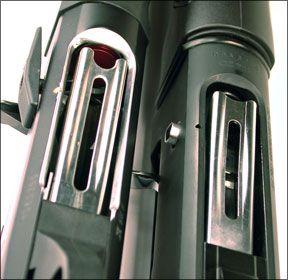
Speed-loading the magazine tube was enhanced by joining the receiver just above the lower radius of the tube. Unloading the 930 magazine without working the bolt was made possible by a quick-release system. With the safety on, push down on the elevator and then press the bolt release. Rounds will now exit the magazine tube. As per page 10 of the owner’s manual, the bolt can then be pulled back to empty the chamber. The only problem we found with this design was the difficulty we encountered when trying to empty the chamber while leaving rounds in the magazine. Empty chamber with rounds in the magazine is commonly referred to as “Vehicle Mode.” Vehicle mode is widely recognized as the proper ready condition for a shotgun that is stowed but in reach, such as inside a patrol car. The procedure for emptying the chamber without disturbing rounds inside the magazine is to pull the bolt back far enough to either reach in and grab the shell or let the ejector kick it out into your hand. We found the ejection port to be of adequate size, but the short travel of the bolt made removing the chambered round difficult. With the bolt pulled to its furthest point before causing another round to be released from the magazine, very little space was left to pick up the round.
At the range we noticed immediately that the soft rubber buttpad was going to grab whatever garment we were wearing and prevent a smooth mount. To overcome this problem we made sure to level the shotgun with the butt away from the body and then pull it straight into the shoulder. But our first task was to establish what kind of pattern we could expect at 10 and 25 yards. Our Mossberg spread nine pellets of the Winchester ammunition over a 5.6-inch pattern at 10 yards. The Federal buckshot printed a tighter group measuring 4.25 inches across. Contrary to popular belief you can’t just point a shotgun in a general direction at short distances. It helps to know the available pattern so that if a surgical shot is necessary a shooter who knows his gun and ammunition can actually deliver a portion of the shot inside a small point of aim. At 25 yards the patterns were larger, doing more to cover a torso-size target. We measured 25-yard patterns to be about 18.8 inches across firing the Winchester buckshot and 12.7 inches across firing the Federal Low Recoil buck. We used an Oehler 35P chronograph to measure velocity so we could compute muzzle energy. We were advised to utilize the widest choke to limit any incidental increase in motion caused by individual shot careening off the walls of the choke or compressing the shot in such a way that multiple shot would be counted as one. But since our 930 Tactical was fitted with fixed-choke barrel (with constriction comparable to a Cylinder choke), we fired through the Oehler Sky Screens as delivered. According to Oehler Research (oehler-research.com), what we were actually measuring was the velocity of the first projectile. Nevertheless, we used the total weight of the nine pellets to compute muzzle energy. The results highlighted the difference in felt recoil between the Winchester buckshot and the Federal Low Recoil 00 buck. The Winchester buckshot fired from the Mossberg provided about 311 ft.-lbs. more muzzle energy than did the Federal rounds.
Slug accuracy at 50 yards ranged from 7 to 10 inches across. But even when fixed in the Caldwell Lead Sled we had difficulty matching point of impact with point of aim. As delivered, shots landed as much as 1 foot high and 1 foot to the right of our intended target. Even with the adjustable rear sight turned all the way down and shifted forward and back on the mount, we were not able to completely dial in our elevation. Cranking the ghost ring left had little effect on windage either, so we were not convinced as to the veracity of rear sight unit. Even if this were completely a result of shooter error, we would nevertheless have preferred different sights. The tall stanchion front sight created a difference between the center of the bore and the line of sight measuring about 1.25 inches. When shooting around or over the top of cover you can think your muzzle is clear but end up taking a chunk out of a door frame, for example. Mounting an optic would certainly make long shots more accurate, but likely further increase the difference between the bore and the line of sight.
In our action test, where we sought to hammer an 8-inch plate from 12 yards with five consecutive shots, several factors played into our performance. The top-mounted safety was quick to operate, but whatever time was being saved was being lost to the extra motion required by our mount. As previously explained, the soft, tacky rubber buttpad wouldn’t let us slide the shogun into our mount. We would solve this by coating the edges of the rubber pad with Slick Eez from kickeezproducts.com. This is a clear liquid that once dried lets the pad slide easily along fabric and leather. Cycling and reliability were excellent, but we think the sights slowed us down. Rather than point naturally at the target and pull the trigger, the ghost ring system forced us to find the target and then find the front sight inside the ghost ring. Our fastest run with sights in place was 1.99 seconds total time with a first shot coming at 1.01 seconds after the sound of the timer. But we didn’t hit the target with all five shots. The only run we had with complete accuracy was when we removed the rear sight and aimed below the steel plate. This run was completed in 1.91 seconds after a 0.85 delay for the first shot. But this run was still markedly slower than our attempts shooting the simpler CZ shotgun. Aside from a simpler sighting system, aids such as barrel porting by Pro Port (about $95 plus shipping from magnaport.com) would have helped us stay on target for quicker follow-up shots. After our tests were complete, we did notice that the trigger and trigger guard assembly was loose and could be moved side to side within the receiver. But the mounting nevertheless appeared to be properly in place, and this did not have an effect on reliability.
Our Team Said: The Mossberg 930 Special Purpose Tactical shotgun was an enjoyable gun to shoot. But other than the extended magazine tube, we’re not sure the other modifications were much help. Of the two available SP Tactical models, we’d wish to keep the seven-round magazine but opt for the plain bead barrel or the open sights from the model 930 Slugster No. 85114. Unfortunately, a call to Mossberg confirmed that custom work or mixing and matching the features of one model to another are not offered at this time.
CZ-USA 712 Utility No. 06029 3-Inch 12 Gauge, $458
The 712 Utility is a gas-operated shotgun featuring a 20-inch barrel with polymer stock and fore end. Aptly described on the cz-usa.com website as being “Appropriately sized for both home defense and varmint control on the ranch,” the 712 looked smaller and more compact than it really was. Perhaps it was its sleek black profile accented by a medium-height vent rib. It also had a bright chrome plated bolt, bolt release button, shell elevator, trigger and safety. The hard rubber buttpad was brief and fit tightly into the taper of the buttstock via a nylon spacer. Of our two test guns, we felt that the CZ transferred less felt recoil. Nevertheless, shooters who typically wear lighter clothing will want a more effective buttpad.
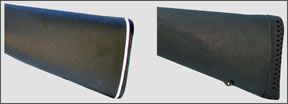
The safety was a crossbolt design mounted at the upper rear of the trigger guard. The trigger was slender and rounded. Together with its smooth-plated finish, it reminded us of a trigger commonly found on a competition revolver. Trigger-pull weight was measured to be about 8 pounds.
Total capacity of the 712 Utility was five rounds. But, as shipped, the magazine tube was limited to two rounds by an internal plug. We removed the plug by unscrewing the magazine cap and fore end. Then we pried off the cap, controlling what was beneath it. Whenever we work against a spring, either installing or removing one, we wear eye protection. This was a good idea here, because with the magazine cap removed, the rod-like plug actually shot outward. The magazine spring itself was captured, however, so there was no need to worry about it leaving the tube or being kinked as the operator tried to control it. The bottom of the loading gate was nearly in line with the lower radius of the magazine tube, so getting shells into the tube was quick and easy. The magazine tube could be unloaded without working the bolt by pushing down on the elevator and pressing the bolt release, which in the context of unloading the magazine on page 10 of the CZ owner’s manual, was referred to as the feed latch.
Emptying the chamber but leaving rounds in the magazine was easier with the CZ than with the Mossberg shotgun, our testers said. To place the CZ in Vehicle Mode, we pulled back the bolt far enough so that the entire shell was exposed. The ejection port of each gun measured about 3 inches long, but the stroke of the CZ allowed the bolt face to travel about 0.4 inches farther to the rear. This made it much easier to remove the shell without engaging the elevator. The bolt could now be closed on an empty chamber. To resume normal cycling, a manual pull of the bolt handle was required. But first the elevator had to be reset. The reset button was located at the rear of the loading port just below the hinge of the elevator.
The barrel of the 712 Utility was threaded for removable chokes. Five tubes—Cylinder, Improved Cylinder, Modified, Improved Modified, and Full—were supplied, along with a sheet-metal wrench. All but the Cylinder tube were approved for use with steel shot. For our tests we chose the Cylinder tube to match the constriction of the Mossberg. Pattern spread at 10 yards measured about 6.8 inches firing the Winchester full-power buckshot and only 4.3 inches across when shooting the Federal Low Recoil buck. Pattern spread at 25 yards was measured to be about 18 inches wide and 14 inches wide for the Winchester and Federal ammunition, respectively. Despite the lack of true sights, the CZ 712 Utility bested the Mossberg shotgun by grouping five shots of our Federal TruBall slugs into a pattern averaging just less than 7 inches across. For full time slug shooting, we would recommend experimenting with different chokes. The receiver was not drilled and tapped for a scope base. If mounting a scope is desired, applying the $80 B-Square Universal Cantilever Mount No. 16175 to the rib gets the job done.
At the rapidfire range we noted that the 712 offered a very quick mount. Some of this could be attributed to its natural balance not being altered by the heavy payload of a long magazine tube. Also, the smooth buttpad allowed us to shoulder the gun quickly. We also noted that we weren’t encumbered by having to line up sights that not only demanded additional visual attention but also precise placement of the shooter’s cheek to the stock.
The CZ ran reliably on any ammunition we found save for the high-brass rounds referred to earlier. Our rapidfire test on the 8-inch plate was performed with the Rio and Estate shotshells. Our first run was tentative, timing in at 2.36 seconds of total time with a 0.94-second first shot. During this run we found the natural aim and limitless field of vision allowed us to hit the plate with all five shots. So we got more aggressive. Elapsed times of about 1.75 seconds became routine after a first shot at about the 0.85-second mark. Our fastest run took 1.63 seconds overall after a 0.77-second first shot. No matter how fast we pushed the CZ, we never missed hitting the plate.
Our Team Said: The 712 Utility proved to be accurate, fast and versatile. It performed just the way it was advertised, if not better. We’re not aware of any aftermarket parts to increase magazine capacity, but the necessary modifications are far from impossible. Some shooters will require a more effective buttpad. Mounting an optic as simple as a red-dot scope would require drilling and tapping the receiver, but cantilever mounts that attach to the rib are available.
0909-SHOTGUNS-ACCURACY-CRONO.pdf





